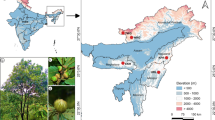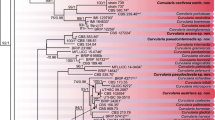Abstract
Austropuccinia psidii is a rust fungus that has expanded its known geographic distribution and host range on Myrtaceae. Invasions by rust fungi are often caused by asexual urediniospores that give rise to populations with low genotypic diversity. Recently it was shown that basidiospores, the gametic spores of A. psidii, were able to infect species of Myrtaceae under controlled conditions. The present study tested the hypothesis that sexual reproduction occurs through infection of Myrtaceae by basidiospores of A. psidii in recently invasive populations from New Zealand and South Africa. We provided three lines of evidence to test this hypothesis: i) presence of a sexual stage, ii) high genotypic diversity within an invasive population, and iii) no genetic linkage between microsatellite markers in multilocus genotypes. Our results provide evidence that invasions of A. psidii are caused by both urediniospores that spread clonal genotypes, and teliospores that produce recombinant basidiospores, which infect Myrtaceae. We reject the hypothesis that field infections of A. psidii are only caused by asexual urediniospores, and support that sexual reproduction occurs in invasive populations and may accelerate adaptation to environmental change.


Similar content being viewed by others
References
Adamack, A. T., & Gruber, B. (2014). PopGenReport: Simplifying basic population genetic analyses in R. Methods in Ecology and Evolution, 5(4), 384–387. https://doi.org/10.1111/2041-210X.12158.
Barrett, S. C. (2015). Foundations of invasion genetics: The baker and Stebbins legacy. Molecular Ecology, 24(9), 1927–1941. https://doi.org/10.1111/mec.13014.
Carnegie, A. J., & Pegg, G. S. (2018). Lessons from the incursion of myrtle rust in Australia. Annual Review of Phytopathology, 56(1), 457–478. https://doi.org/10.1146/annurev-phyto-080516-035256.
Carvalho, C. R., Fernandes, R. C., Carvalho, G. M. A., Barreto, R. W., & Evans, H. C. (2011). Cryptosexuality and the genetic diversity paradox in coffee rust, Hemileia vastatrix. PLoS One, 6(11), e26387. https://doi.org/10.1371/journal.pone.0026387.
Coutinho, T. A., Wingfield, M. J., Alfenas, A. C., & Crous, P. W. (1998). Eucalyptus rust: A disease with the potential for serious international implications. Plant Disease, 82(7), 819–825. https://doi.org/10.1094/pdis.1998.82.7.819.
De Meeûs, T., Lehmann, L., & Balloux, F. (2006). Molecular epidemiology of clonal diploids: A quick overview and a short DIY (do it yourself) notice. Infection, Genetics and Evolution, 6(2), 163–170. https://doi.org/10.1016/j.meegid.2005.02.004.
Drenth, A., McTaggart, A. R., & Wingfield, B. D. (2019). Fungal clones win the battle, recombination wins the war. IMA Fungus, 10(18), 1–6. https://doi.org/10.1186/s43008-019-0020-8.
du Plessis, E., Granados, G. M., Barnes, I., Ho, W. H., Alexander, B. J. R., Roux, J., et al. (2019). The pandemic strain of Austropuccinia psidii causes myrtle rust in New Zealand and Singapore. Australasian Plant Pathology, 48, 253–256. https://doi.org/10.1007/s13313-019-0624-x.
Figueiredo, M. B. (2001). Life cycle and ecology of Puccinia psidii. O Biologico, 63, 69–71.
Figueiredo, M. B., Coutinho, L. N., & Hennen, J. F. (1984). Studies on the determination the life cycle of Puccinia psidii Winter. Summa Phytopathologica, 10, 53–54.
Gladieux, P., Feurtey, A., Hood, M. E., Snirc, A., Clavel, J., Dutech, C., et al. (2015). The population biology of fungal invasions. Molecular Ecology, 24(9), 1969–1986. https://doi.org/10.1111/mec.13028.
Graça, R. N., Ross-Davis, A. L., Klopfenstein, N. B., Kim, M.-S., Peever, T. L., Cannon, P. G., Aun, C. P., Mizubuti, E. S., & Alfenas, A. C. (2013). Rust disease of eucalypts, caused by Puccinia psidii, did not originate via host jump from guava in Brazil. Molecular Ecology, 22(24), 6033–6047. https://doi.org/10.1111/mec.12545.
Granados, G. M., McTaggart, A. R., Barnes, I., Rodas, C. A., Roux, J., & Wingfield, M. J. (2017). The pandemic biotype of Austropuccinia psidii discovered in South America. Australasian Plant Pathology, 46(3), 267–275. https://doi.org/10.1007/s13313-017-0488-x.
Grunwald, N. J., Everhart, S. E., Knaus, B. J., & Kamvar, Z. N. (2017). Best practices for population genetic analyses. Phytopathology, 107(9), 1000–1010. https://doi.org/10.1094/phyto-12-16-0425-rvw.
Ho, W. H., Baskarathevan, J., Griffin, R. L., Quinn, B. D., Alexander, B. J. R., Havell, D., et al. (2019). First report of myrtle rust caused by Austropuccinia psidii on Metrosideros kermadecensis on Raoul Island and on M. excelsa in Kerikeri, New Zealand. Plant Disease, PDIS-12-18-2243-PDN. https://doi.org/10.1094/PDIS-12-18-2243-PDN.
Huson, D. H., & Bryant, D. (2005). Application of phylogenetic networks in evolutionary studies. Molecular Biology and Evolution, 23(2), 254–267. https://doi.org/10.1093/molbev/msj030.
Joffily, J. (1944). Ferrugem do eucalipto. Bragantia, 4, 475–487.
Kamvar, Z. N., Tabima, J. F., & Grünwald, N. J. (2014). Poppr: An R package for genetic analysis of populations with clonal, partially clonal, and/or sexual reproduction. PeerJ, 2, e281. https://doi.org/10.7717/peerj.281.
Kosman, E., & Leonard, K. J. (2005). Similarity coefficients for molecular markers in studies of genetic relationships between individuals for haploid, diploid, and polyploid species. Molecular Ecology, 14(2), 415–424. https://doi.org/10.1111/j.1365-294X.2005.02416.x.
Kosman, E., & Leonard, K. J. (2007). Conceptual analysis of methods applied to assessment of diversity within and distance between populations with asexual or mixed mode of reproduction. New Phytologist, 174(3), 683–696. https://doi.org/10.1111/j.1469-8137.2007.02031.x.
Machado, P. d. S., Alfenas, A. C., Alfenas, R. F., Mohammed, C. L., & Glen, M. (2015). Microsatellite analysis indicates that Puccinia psidii in Australia is mutating but not recombining. Australasian Plant Pathology, 44(4), 455–462. https://doi.org/10.1007/s13313-015-0364-5.
McDonald, B. A., & Linde, C. (2002). The population genetics of plant pathogens and breeding strategies for durable resistance. [journal article]. Euphytica, 124(2), 163–180. https://doi.org/10.1023/a:1015678432355.
McTaggart, A. R., Shuey, L. S., Granados, G. M., du Plessis, E., Fraser, S., Barnes, I., et al. (2018). Evidence that Austropuccinia psidii may complete its sexual life cycle on Myrtaceae. Plant Pathology, 67, 729–734. https://doi.org/10.1111/ppa.12763.
Meirmans, P. G., & Van Tienderen, P. H. (2004). GenoType and GenoDive: Two programs for the analysis of genetic diversity of asexual organisms. Molecular Ecology Notes, 4(4), 792–794. https://doi.org/10.1111/j.1471-8286.2004.00770.x.
Milgroom, M. G. (1996). Recombination and the multilocus structure of fungal populations. Annual Review of Phytopathology, 34, 457–477. https://doi.org/10.1146/annurev.phyto.34.1.457.
Morin, L., Talbot, M. J., & Glen, M. (2014). Quest to elucidate the life cycle of Puccinia psidii sensu lato. Fungal Biology, 118, 253–263.
Nieuwenhuis, B. P. S., & James, T. Y. (2016). The frequency of sex in fungi. Philosophical Transactions of the Royal Society B: Biological Sciences, 371, 20150540. https://doi.org/10.1098/rstb.2015.0540.
R Core Team. (2014). R: A language and environment for statistical computing. Vienna, Austria: R Foundation for Statistical Computing.
Rangel, E. (1916). Contribuiçao para e estudo dos Puccinias das Myrtacéas. Archivos do Museu Nacional do Rio de Janeiro, 18, 147–156.
Roux, J., Greyling, I., Coutinho, T. A., Verleur, M., & Wingfield, M. J. (2013). The myrtle rust pathogen, Puccinia psidii, discovered in Africa. IMA Fungus, 4(1), 155–159.
Roux, J., Granados, G. M., Shuey, L., Barnes, I., Wingfield, M. J., & McTaggart, A. R. (2016). A unique genotype of the rust pathogen, Puccinia psidii, on Myrtaceae in South Africa. Australasian Plant Pathology, 45, 645–652. https://doi.org/10.1007/s13313-016-0447-y.
Ruiz, R. A. R., Alfenas, A. C., Ferreira, F. A., & Vale, F. X. R. (1989). Influência da temperatura, do tempo de molhamento foliar, fotoperíodo e intensidade de luz sobre a infecção de Puccinia psidii em eucalipto. Fitopatologia Brasileira, 14, 55–61.
Sandhu, K. S., Karaoglu, H., Zhang, P., & Park, R. F. (2016). Simple sequence repeat markers support the presence of a single genotype of Puccinia psidii in Australia. Plant Pathology, 65, 1084–1094.
Soewarto, J., Carriconde, F., Hugot, N., Bocs, S., Hamelin, C., & Maggia, L. (2017). Impact of Austropuccinia psidii in New Caledonia, a biodiversity hotspot. Forest Pathology, 48(2), e12402. https://doi.org/10.1111/efp.12402.
Stewart, J. E., Ross-Davis, A. L., Graҫa, R. N., Alfenas, A. C., Peever, T. L., Hanna, J. W., et al. (2017). Genetic diversity of the myrtle rust pathogen (Austropuccinia psidii) in the Americas and Hawaii: Global implications for invasive threat assessments. Forest Pathology, 48, e12378. https://doi.org/10.1111/efp.12378.
Taylor, J. W., Hann-Soden, C., Branco, S., Sylvain, I., & Ellison, C. E. (2015). Clonal reproduction in fungi. Proceedings of the National Academy of Sciences, 112(29), 8901–8908. https://doi.org/10.1073/pnas.1503159112.
Valdes, A. M., Slatkin, M., & Freimer, N. B. (1993). Allele frequencies at microsatellite loci: The stepwise mutation model revisited. Genetics, 133(3), 737–749.
Winter, G. (1884). Dr. L. Rabenhorst's Kryptogamen-Flora von Deutschland, Oesterreich und der Schweiz. Erster Band: Pilze (Vol. 1, pt. 1). Leipzig: Verlag von Eduard Kummer.
Wu, J. Q., Dong, C., Song, L., Cuomo, C. A., & Park, R. F. (2019). Dissecting the first phased dikaryotic genomes of the wheat rust pathogen Puccinia triticina reveals the mechanisms of somatic exchange in nature. bioRxiv, https://doi.org/10.1101/705475.
Zhong, S., Yang, B., & Alfenas, A. C. (2008). Permanent genetic resources: Development of microsatellite markers for the guava rust fungus, Puccinia psidii. Molecular Ecology Resources, 8(2), 348–350. https://doi.org/10.1111/j.1471-8286.2007.01952.x.
Acknowledgements
We are grateful to Kate and Graham Grieve (Custodians of Rare and Endangered Wildflowers, CREW), as well as Jackie Cossey, Izette Greyling, Giovanni Sale, Christo van Zyl and Henk du Plessis for providing or assisting in collection of samples for this study. This work is based on research partially supported by the Tree Protection Co-operative Programme (TPCP) and the National Research Foundation of South Africa (Grant specific unique reference numbers UID 78566 and UID 83924) and the DST-NRF Centre of Excellence in Tree Health Biotechnology (CTHB). The grant holders acknowledge that opinions, findings and conclusions or recommendations expressed in any publication generated by NRF supported research are that of the authors and that the NRF accepts no liability whatsoever in this regard. ARM acknowledges the University of Queensland Development Fellowships (UQFEL1718905) and support from the Department of the Environment and Energy under the Australian Biological Resources Study (grant number RG18-43). This work was partly funded by the New Zealand Ministry of Business, Innovation and Employment (C09X1806), and the Australian Plant Biosecurity Science Foundation (PBSF018). We thank Luke Barrett and eight anonymous reviewers who have helped improve previous submissions of this manuscript.
Author information
Authors and Affiliations
Corresponding author
Ethics declarations
The authors declare that there are no potential conflicts of interest and that the study did not involve human participants or animals.
Rights and permissions
About this article
Cite this article
McTaggart, A.R., du Plessis, E., Roux, J. et al. Sexual reproduction in populations of Austropuccinia psidii. Eur J Plant Pathol 156, 537–545 (2020). https://doi.org/10.1007/s10658-019-01903-y
Accepted:
Published:
Issue Date:
DOI: https://doi.org/10.1007/s10658-019-01903-y




